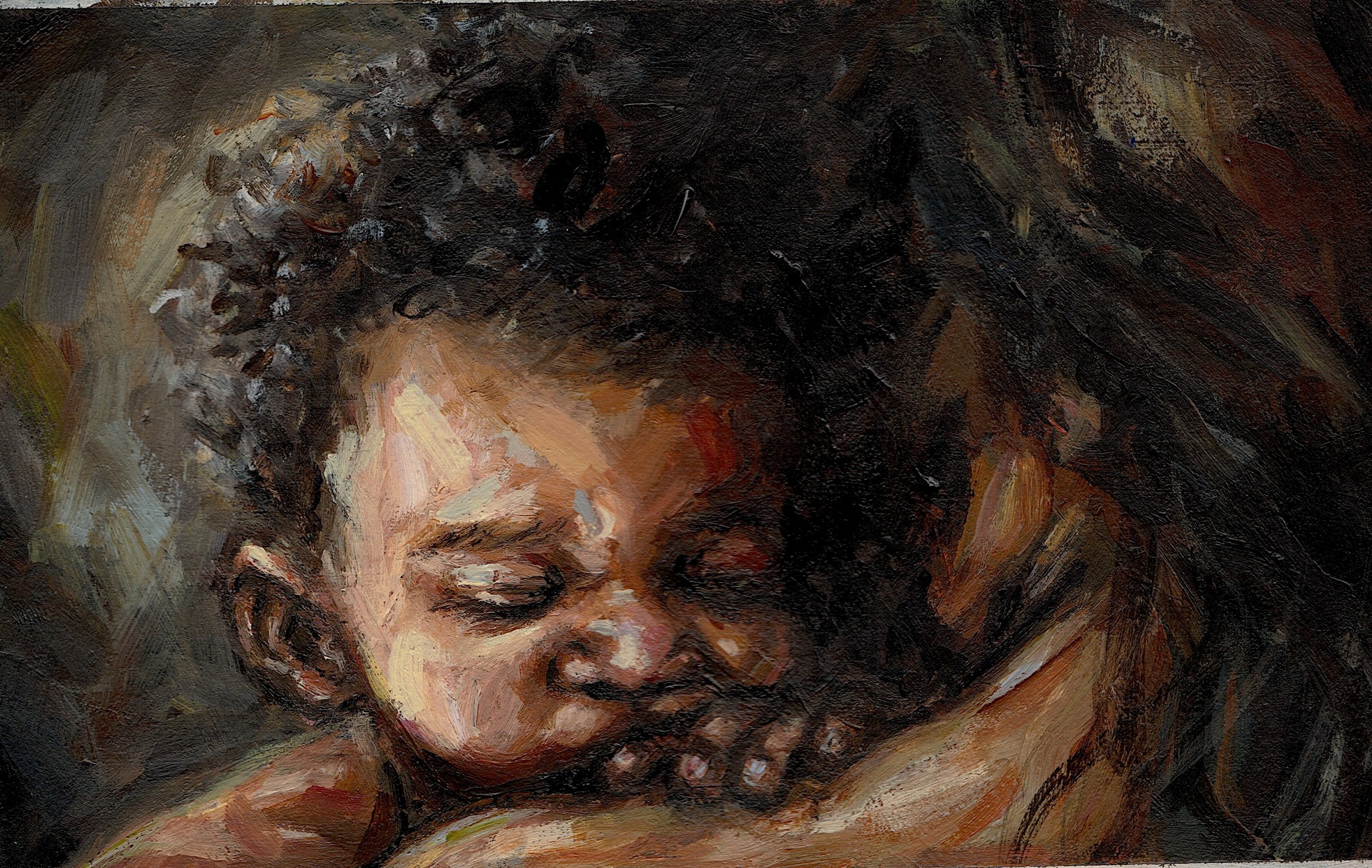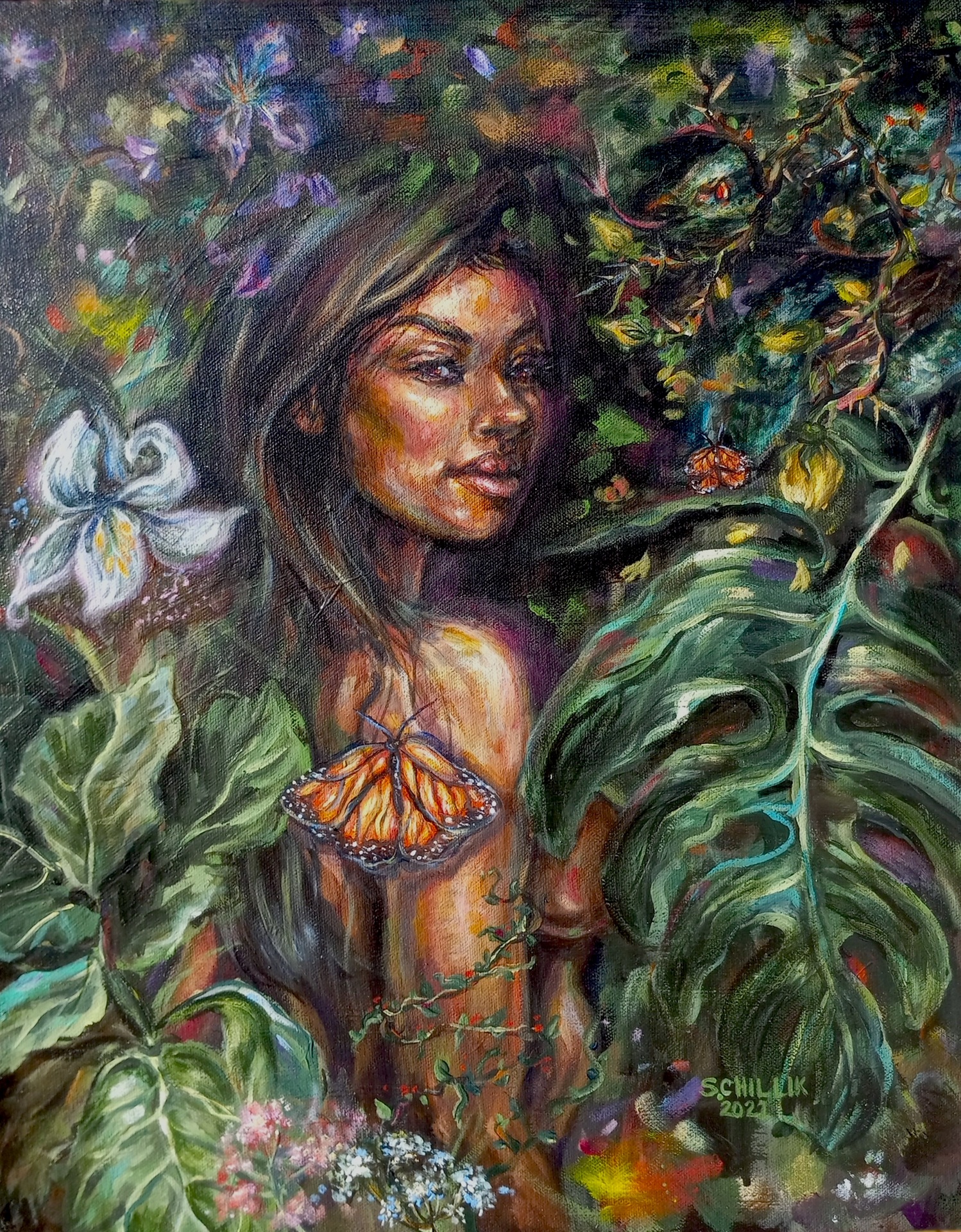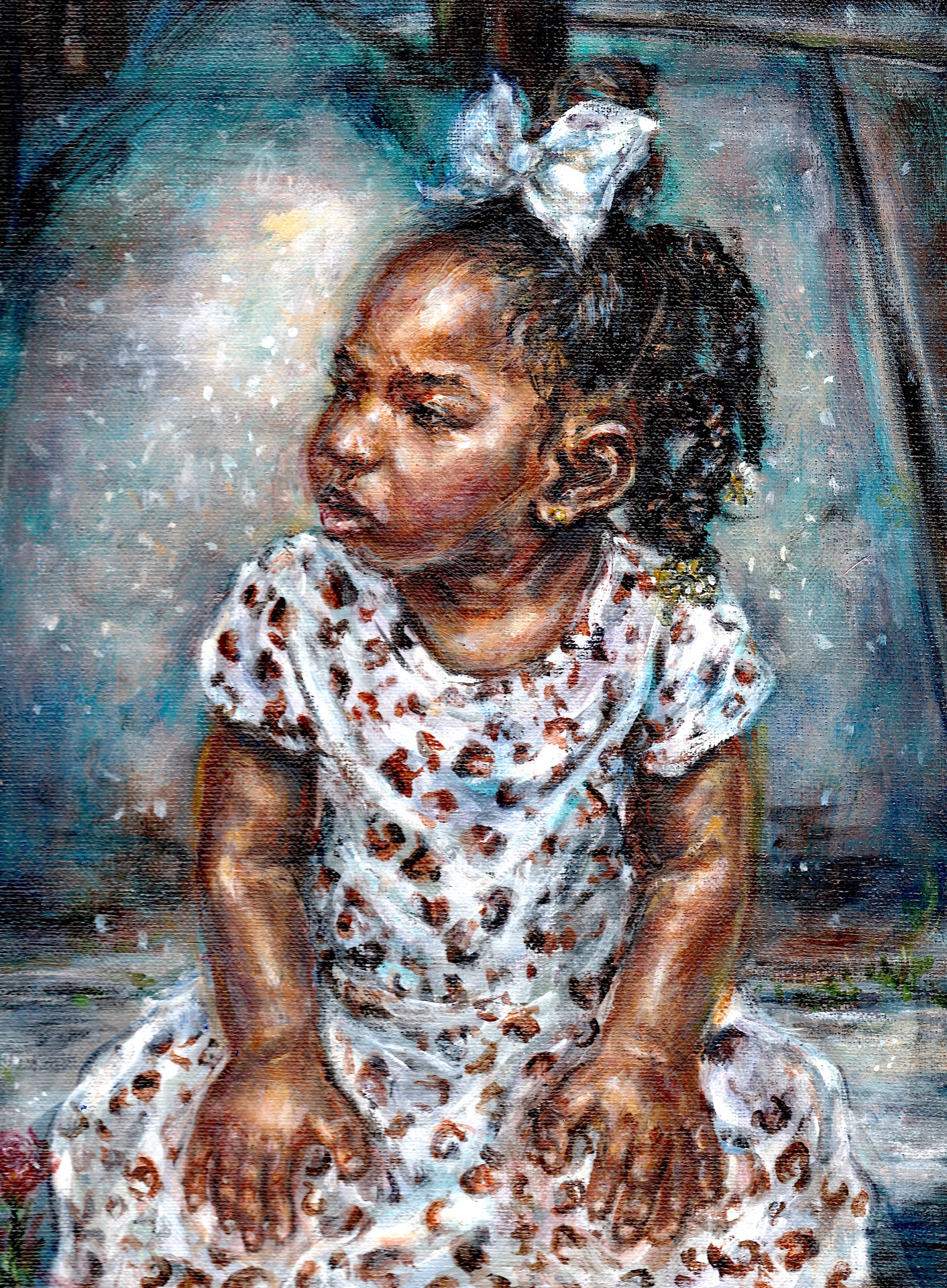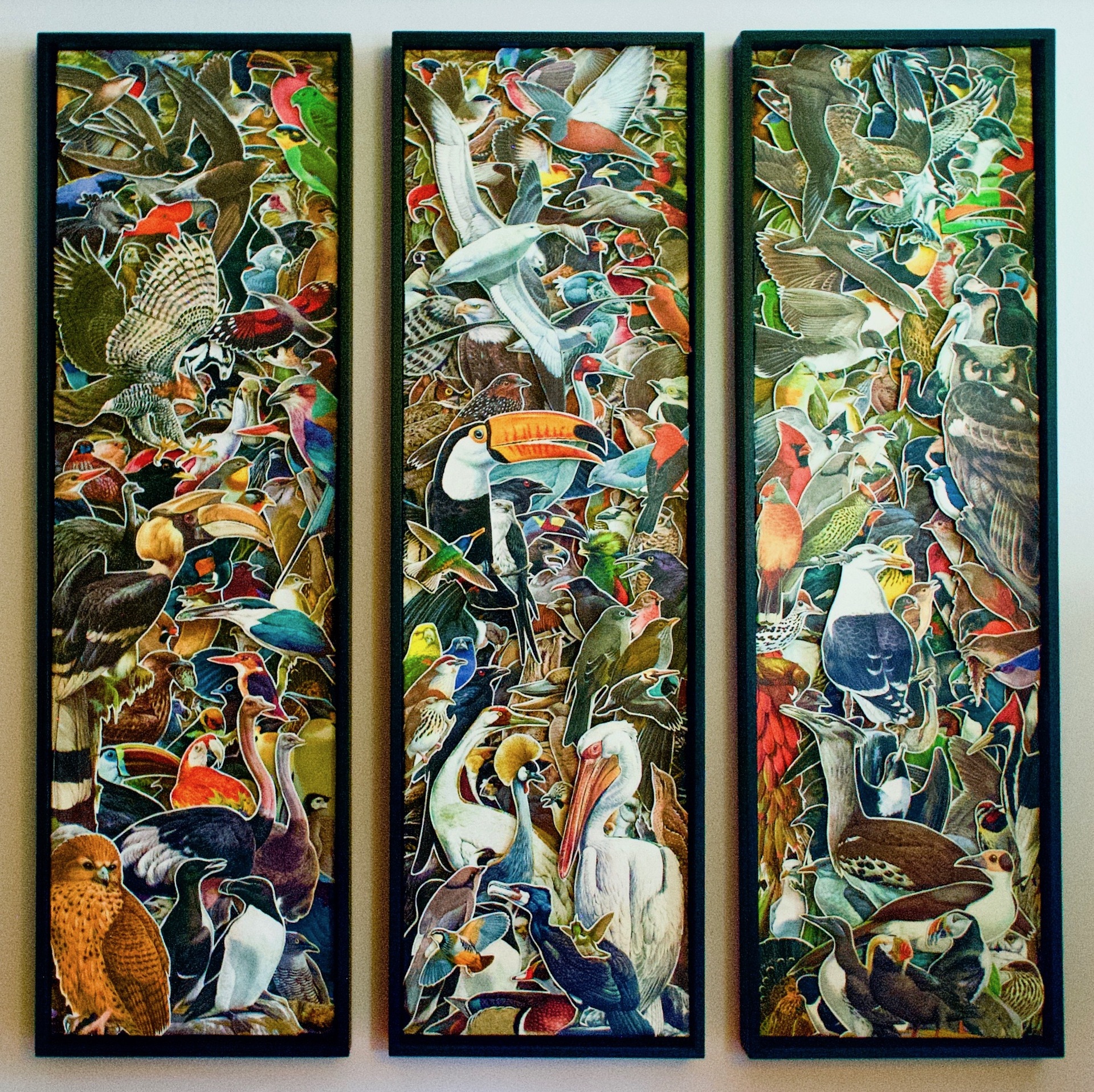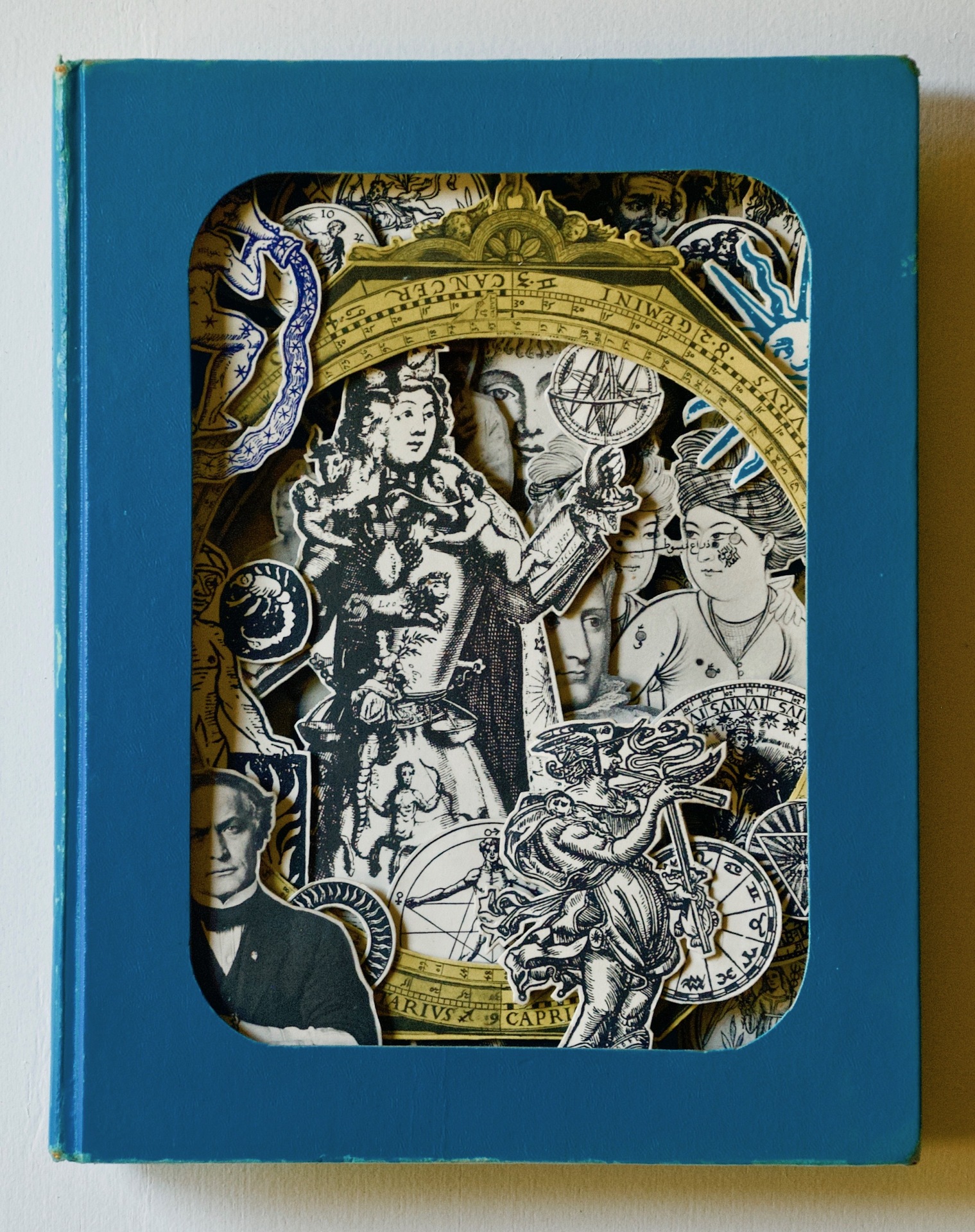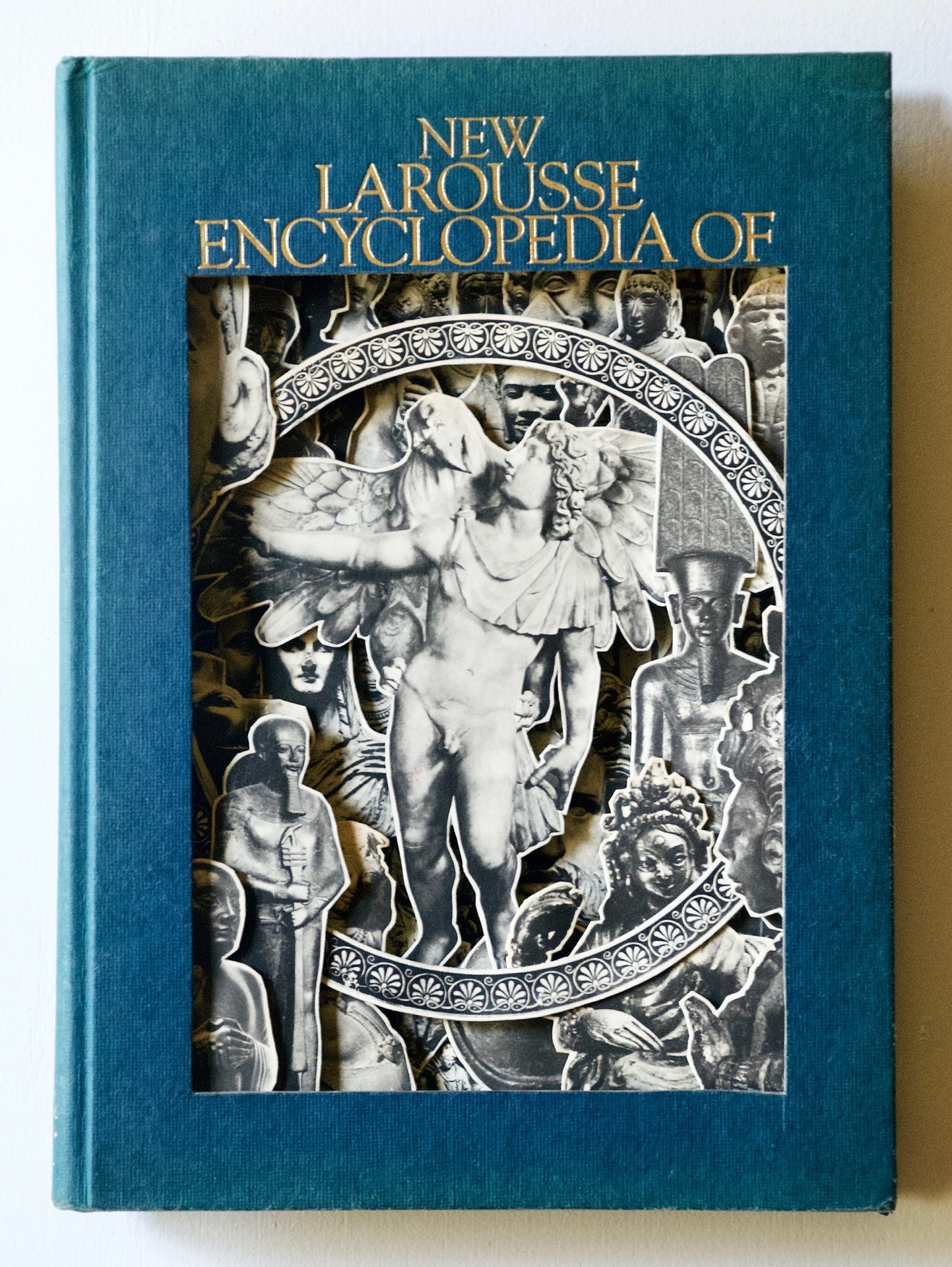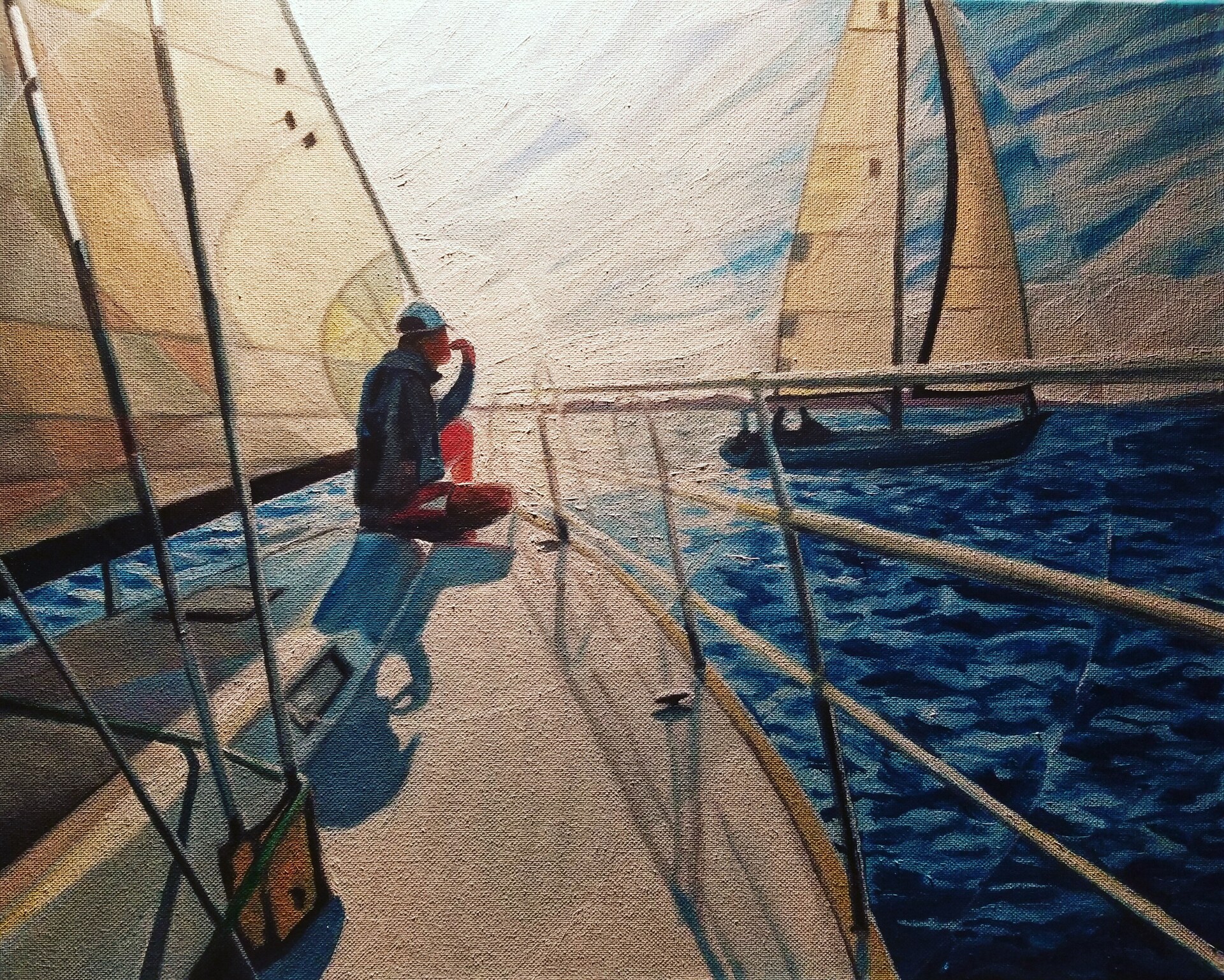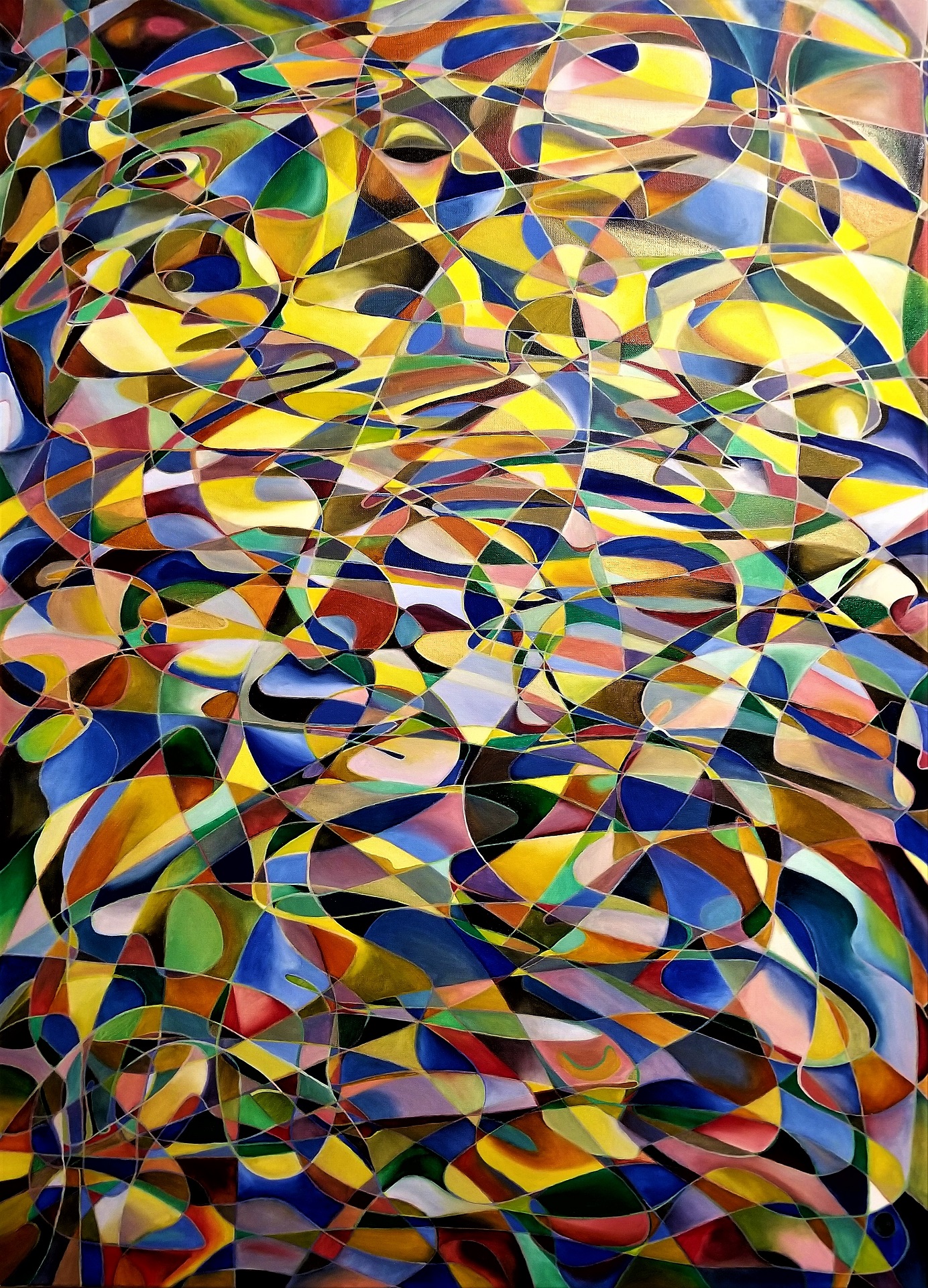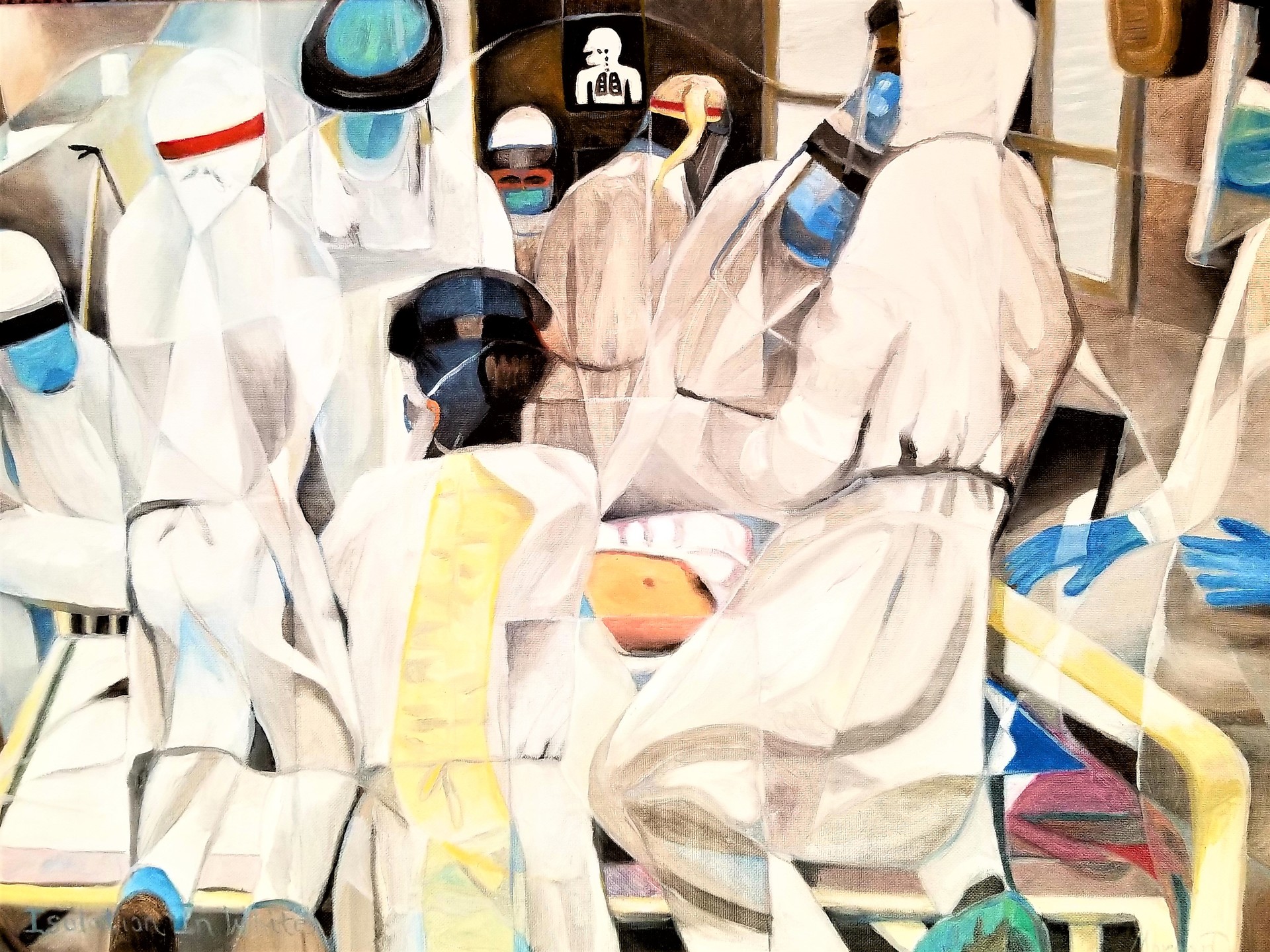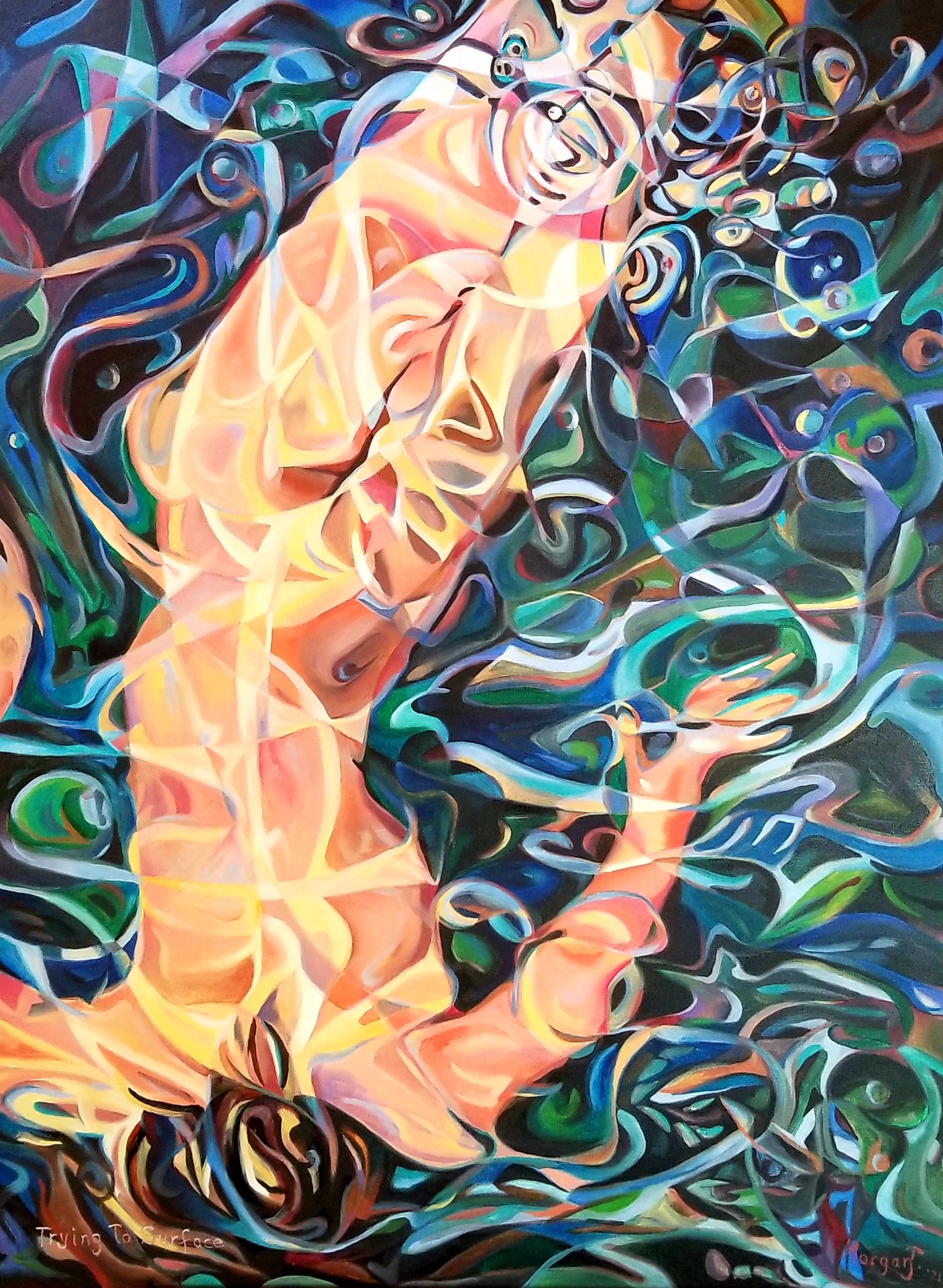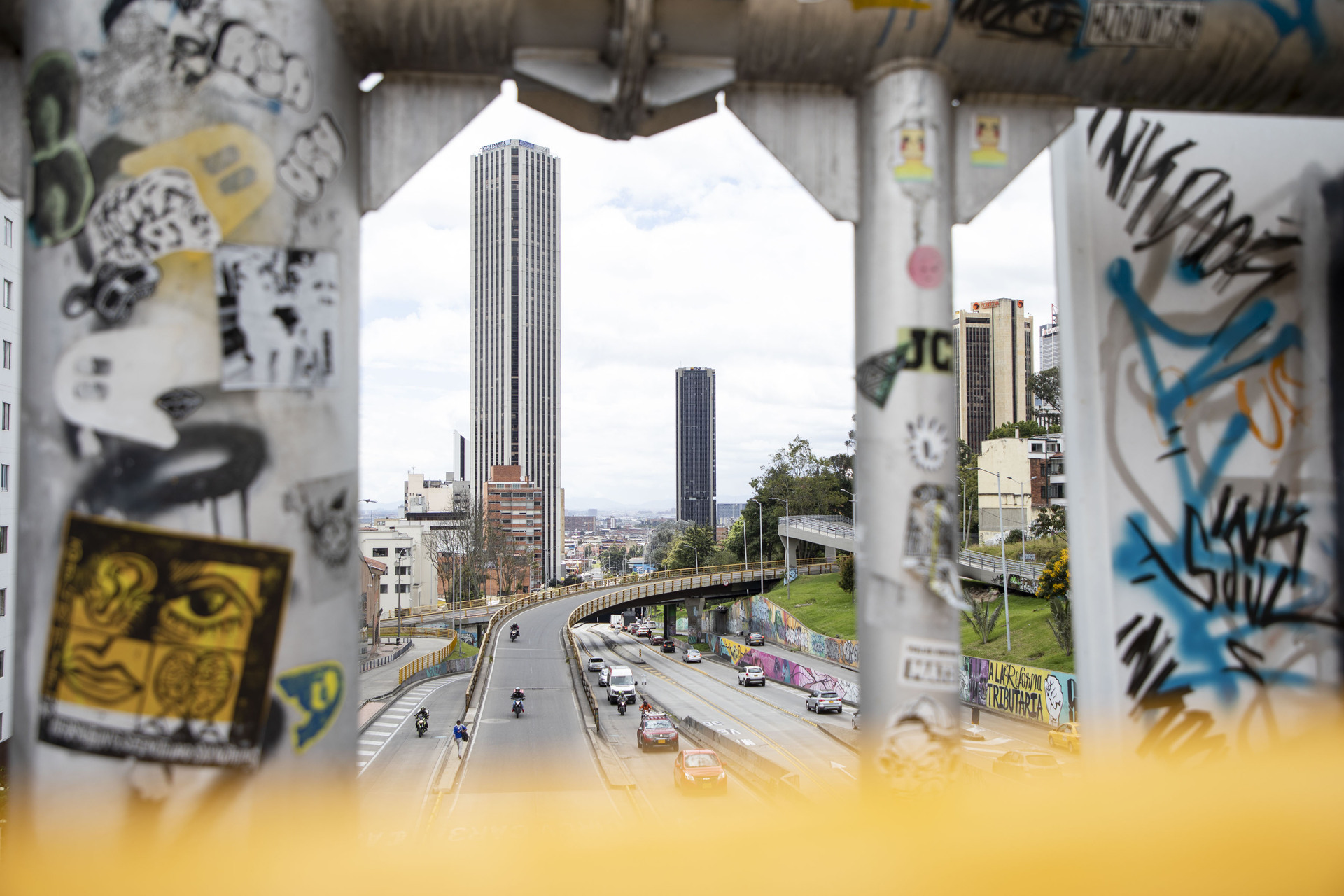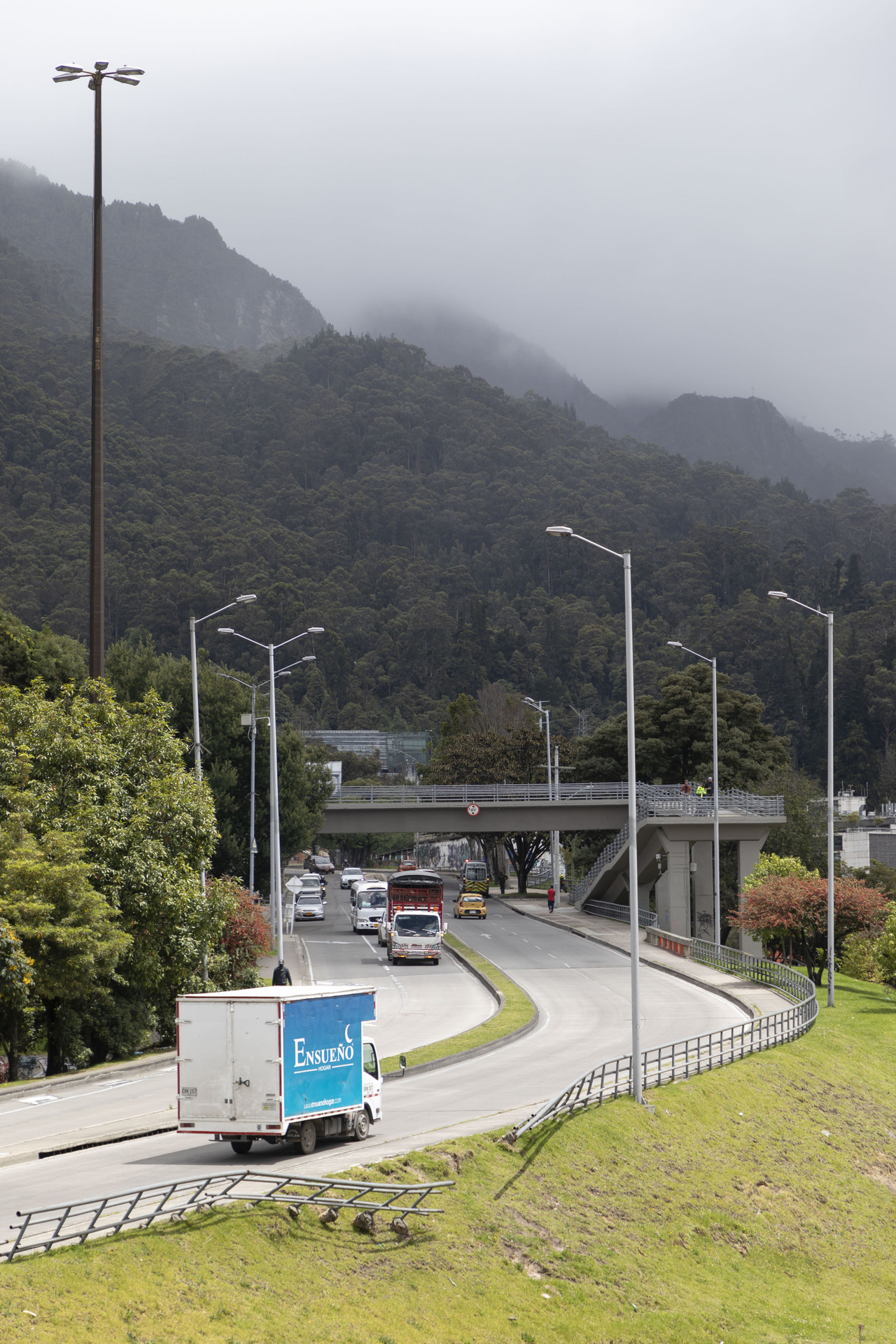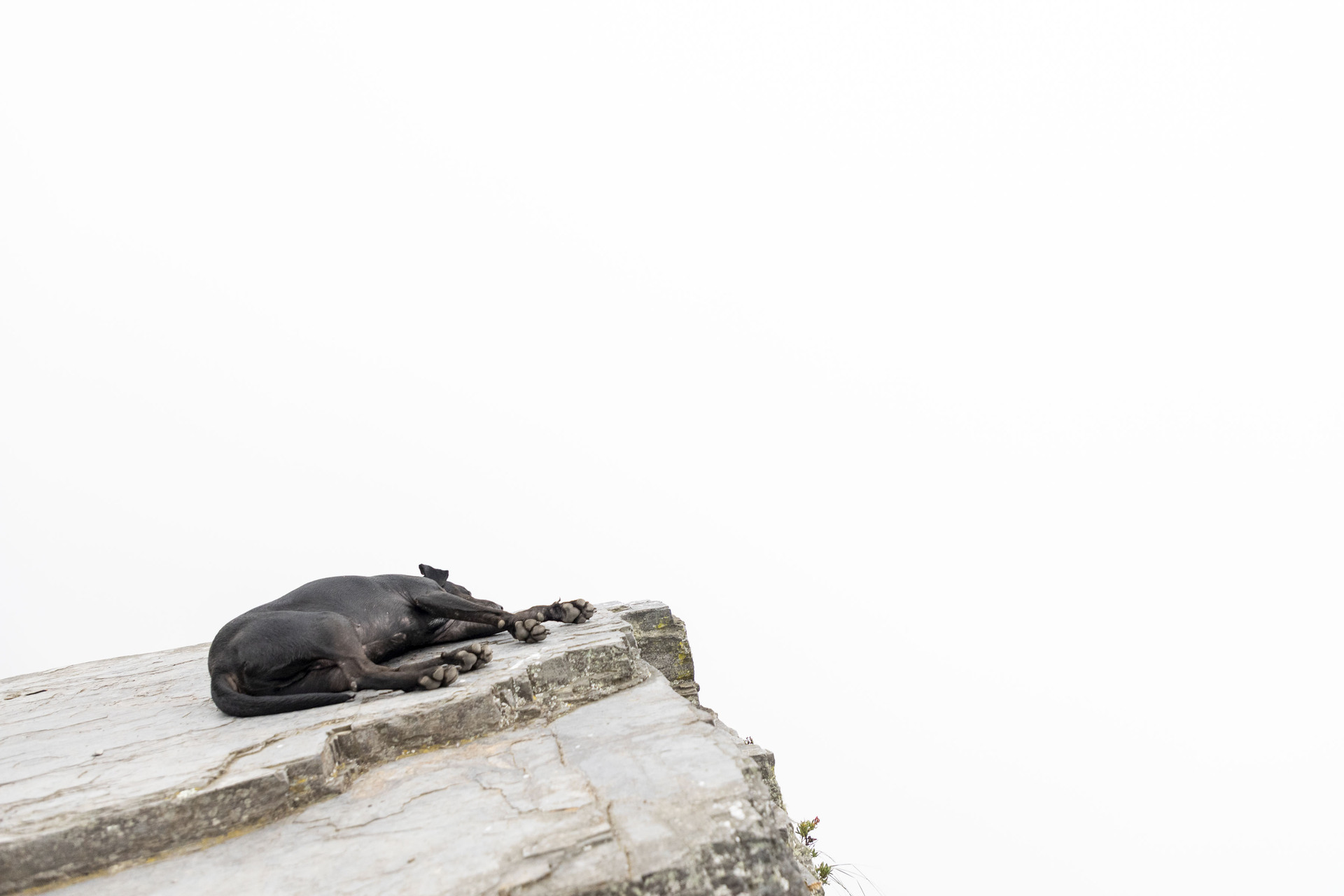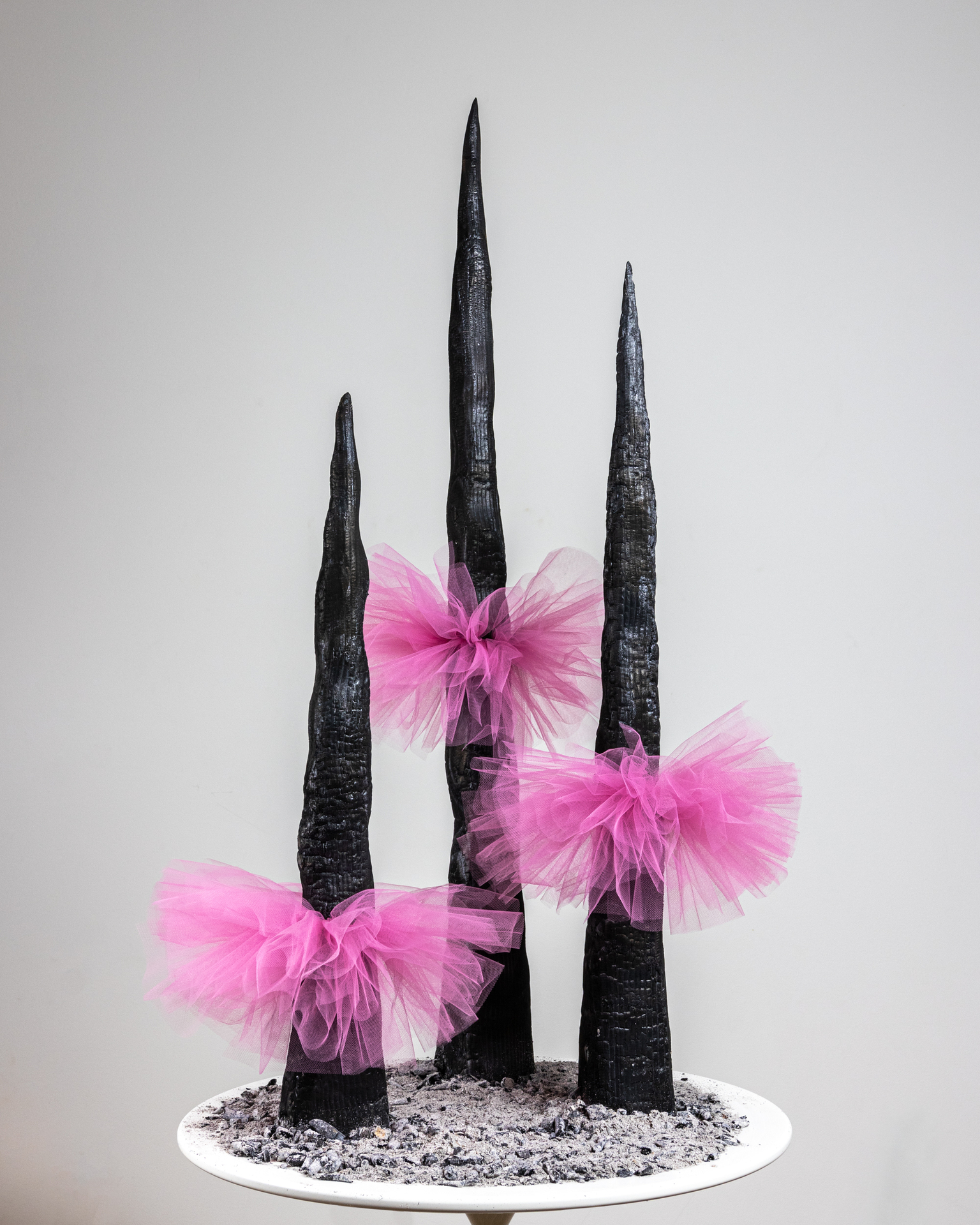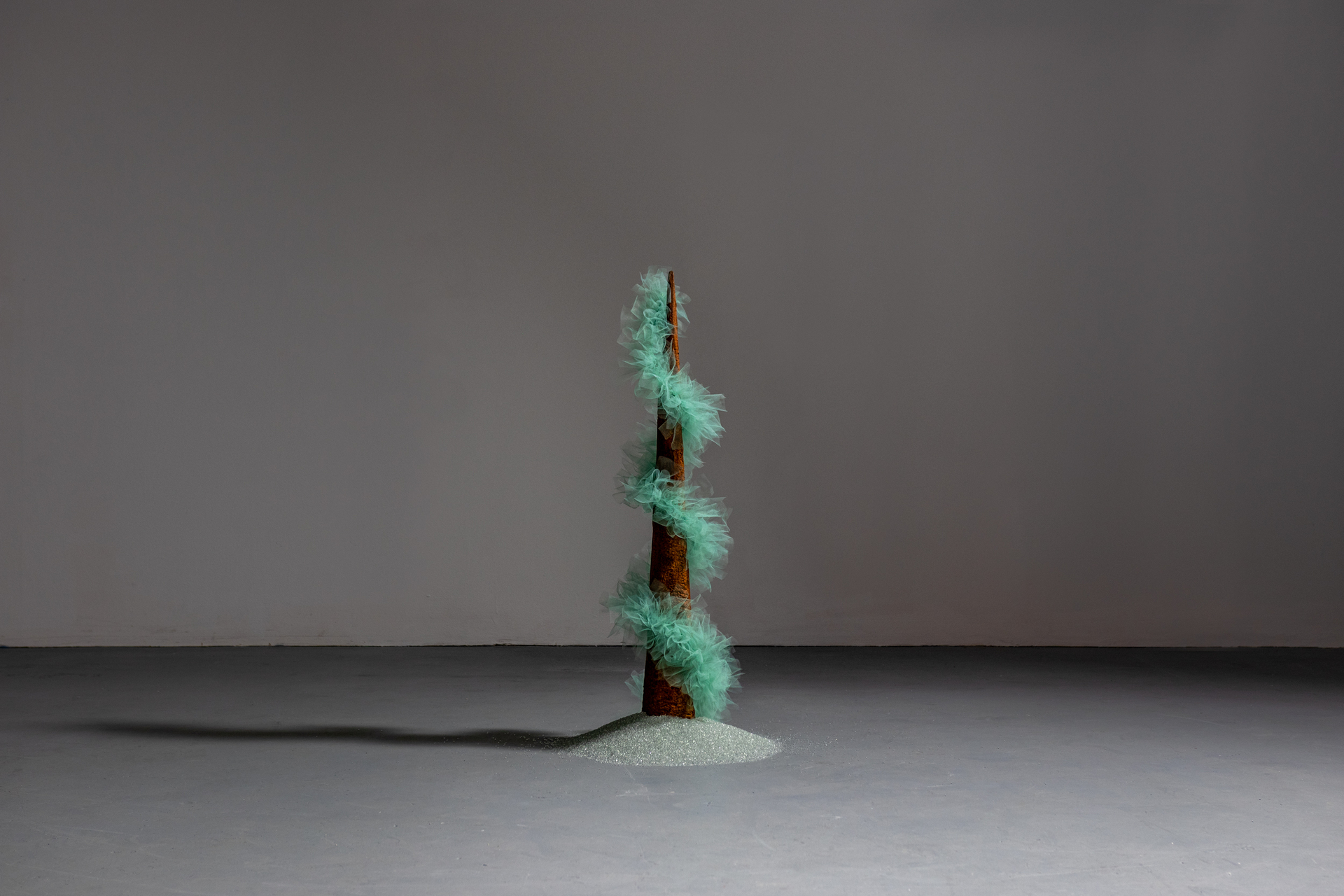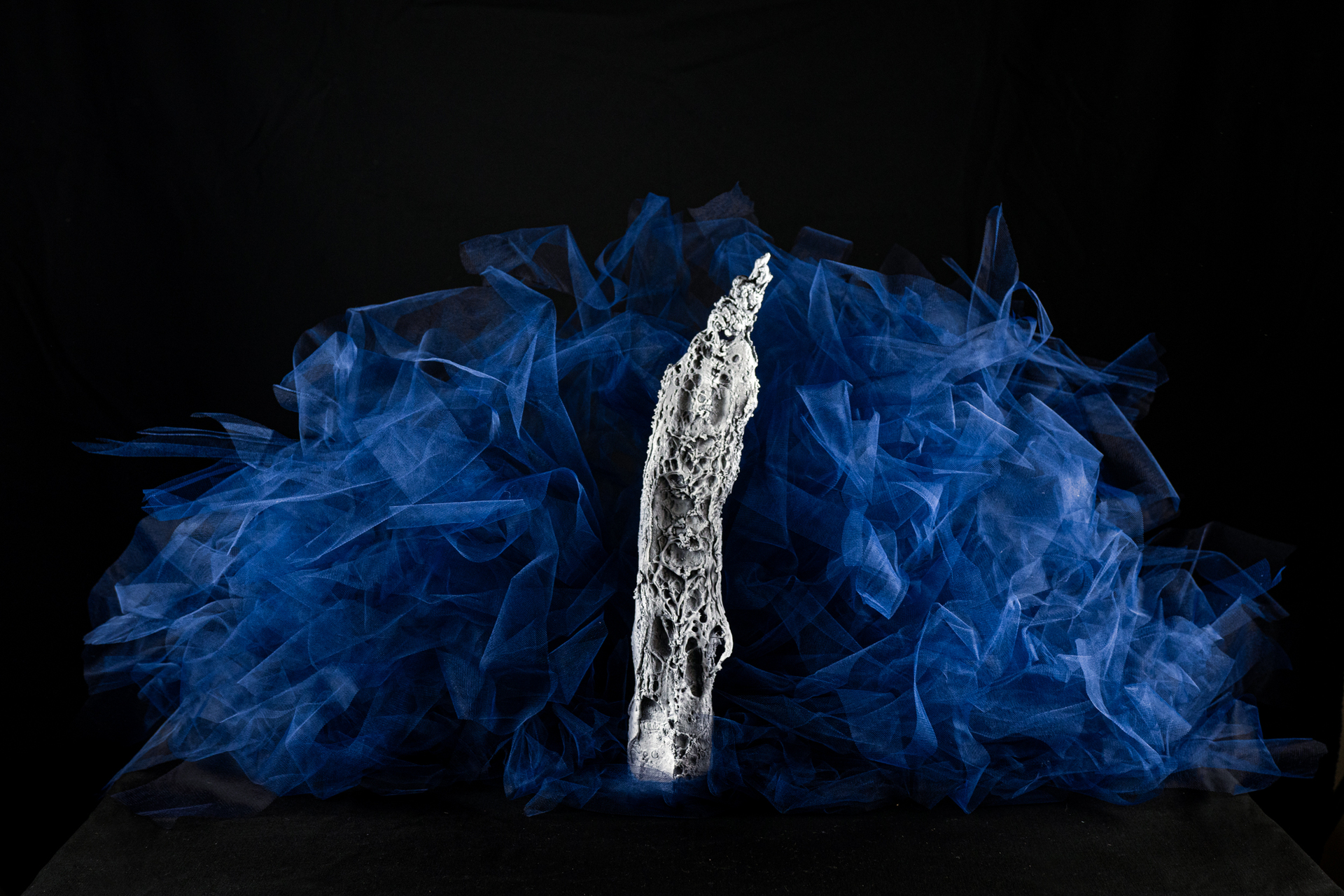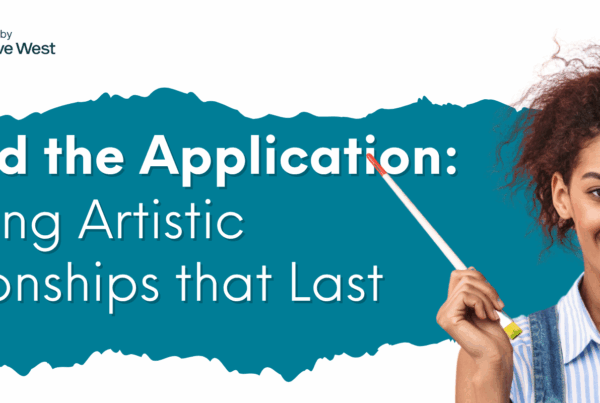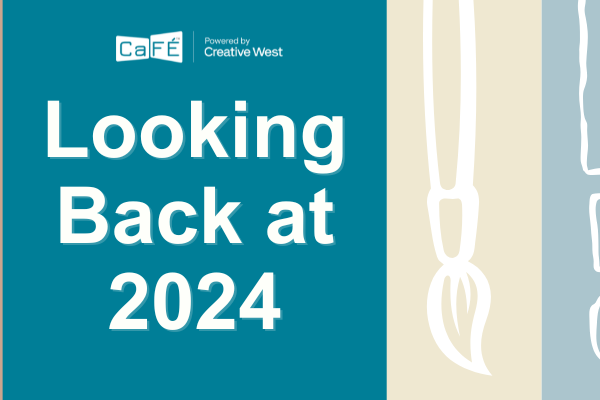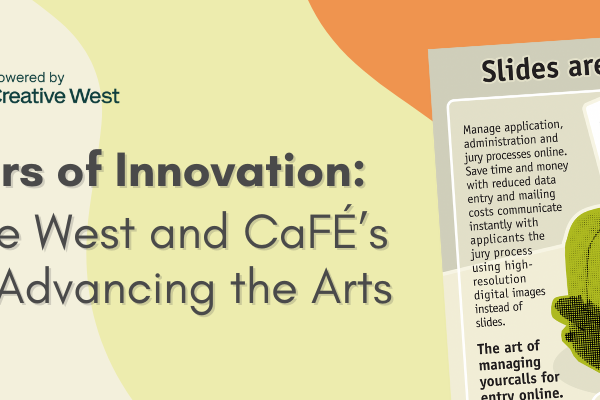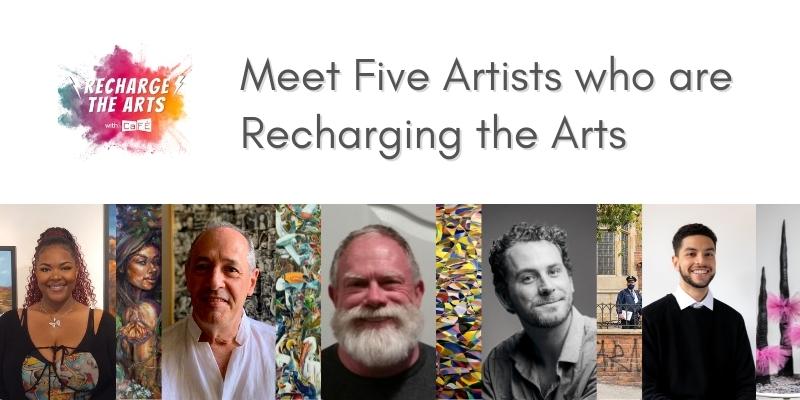
Last December, CaFÉ opened Recharge the Arts, a call for entry which was originally intended to feature artwork throughout our website and our Instagram page. Beyond that, the goal behind Recharge the Arts is to showcase the resiliency, hope, and endurance of the community of artists that use CaFÉ following years of hardship caused by the pandemic, ongoing racial injustice, climate change, and more.
After receiving over 1,700 artwork submissions from more than 400 artists around the country, we hope to showcase even more of the incredible talent from the artist community. In this blog post, we are highlighting five artists whose work has been inspired by or created during these recent challenges. Featuring Sherell Chillik, Tony Dagradi, Morgan Johnson, Arthur Kobin, and Daniel Merkowitz-Bustos, you can read more about each artist, view their artwork, and read a short Q&A with each artist to find out just what they are doing to recharge the arts!
Sherell Chillik
Website: rellrepublica.com
Instagram: @rellrepublicaarte
Sherell Chillik was born in 1993 in Detroit, Michigan. She lives and works in Flint, Michigan where she teaches private and public art classes and participates in local art events and fairs to engage with her community. She received her Bachelor of Fine Arts, in painting, at College For Creative Studies in 2018 and participated in the AICAD Residency in Dumbo, Brooklyn, New York, and Rogers Art Loft Residency in 2022. From 2012 to 2015, Chillik volunteered to create murals around the Brightmoor community of Detroit. Her most recent shows include All Media Exhibition at Detroit Artist Market, “Tropic of Color” in Pittsburgh Pennsylvania, “BIPOC” at Buckham Gallery in Flint MI, and solo show “Redeemable” at Roger’s Studio Gallery in Las Vegas NV.
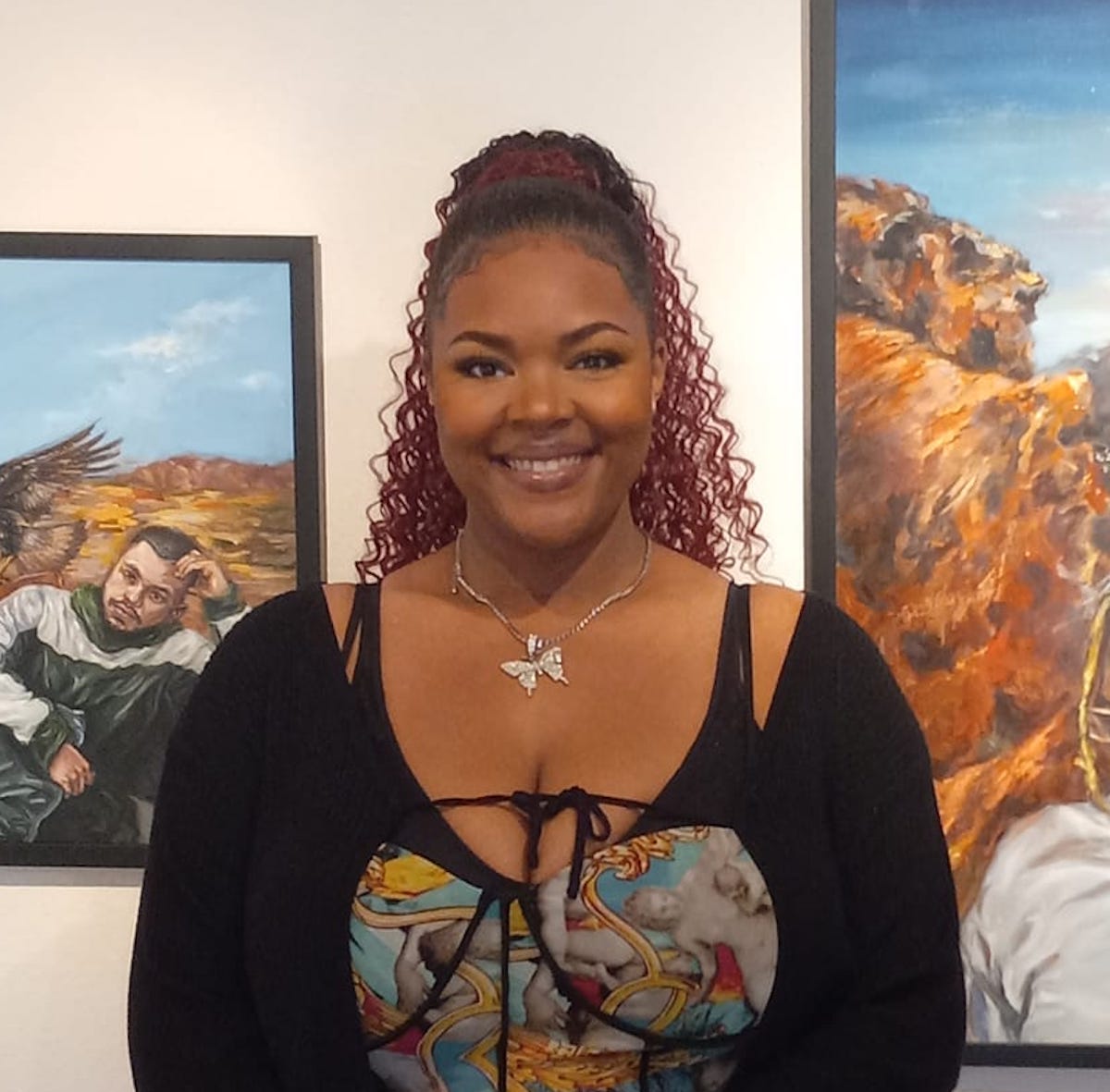
Artist Statement: Sherell Chillik’s work explores portraiture and biblical texts’ relationship with postmodern times. Through portraiture, she navigates through the natural world with a spiritual lens. She uses family and social media acquaintances as references. Ideas start with portraits of family members and friends, then narratives develop into biographical stories surrounding her Christian spiritual journey. She explores themes of loneliness, isolation, pain, messages hidden in plain sight, blackness, and violence within church culture.
View Q&A with Sherell Chillik
Q: Amid a growing list of challenges our society faces today (the COVID-19 pandemic, ongoing racial injustice, climate change, gun violence, etc.), how has your artwork been influenced or affected?
A: Due to the ongoing racial tensions during the pandemic, there was a push toward showcasing artwork from creatives of color, and I benefited greatly from it. The influence of these worldwide events also affected my work in a negative way due to fitting the BIPOC criteria while not applying to the trending “Black suffering” list.
Q: What are your hopes or goals for the future as we emerge from the pandemic?
A: I’m ready to move on from the pandemic. I’m ready to experience more art in person, engage with my audience at public events, and pursue making a living from my work again.
Tony Dagradi
Website: www.tonydagradi.com
Instagram: @tonydagradi
Tony Dagradi is an internationally recognized jazz performer, artist, composer, author and educator. He has appeared with Ellis Marsalis, Bobby McFerrin, Carla Bley, Nat Adderley, Mose Allison, Professor Longhair, Astral Project, and many others. In his work with altered books, he utilizes antiquarian texts, vintage encyclopedias, technical manuals, modern books and graphic novels. The results of his methods allow the contents and imagery of long outdated material to be viewed in a manner that is both exciting and thought-provoking. Dagradi has participated in numerous group and solo exhibitions around the country and has been featured at both the Contemporary Arts Center and the Ogden Museum in New Orleans. He is currently represented exclusively by Jonathan Ferrara Gallery.
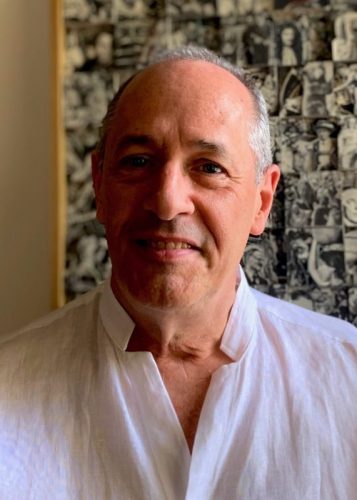
Artist Statement: My decades-long career in contemporary jazz directly informs my work as a visual artist. Music, for me, has always had a visual component, with the diverse elements of music suggesting colors, shapes and textures. The juxtaposition of abstract shapes which come together as I work on a book, is very much how I perceive the interplay of melody, harmony and rhythm.
Since 2015, I have been exploring the visual possibilities of altered books. Choosing from antiquarian texts, vintage encyclopedias, technical manuals, modern books and graphic novels, I carefully cut through one page at a time rearranging existing images to create a three-dimensional collage.
Improvisation is also key to my approach in both genres. Within a jazz ensemble, each player is responsible for an individual part which must support and inspire the other musicians. In the heat of the moment, unexpected phrases or motivic ideas can affect surprising new directions for the collective ensemble.
Similarly, the tension and harmony which naturally occur as I uncover each new image unfailingly impacts the whole and often shifts the form and concept of an emerging composition. While cutting through each book page by page to expose selected subject matter is primarily a subtractive process, I often choose to reserve images for later use. This too is comparable to the open-ended conversation on the bandstand and provides me with control over the development of each piece.
I especially enjoy working with vintage books and encyclopedias. The eclectic photos and illustrations represent material that is long out of date, yet offer a fascinating window into our past. Ultimately, I hope to provide a perspective on the transitory nature of what earlier generations understood to be factual and offer insight into the way ever-evolving media has shaped contemporary perspectives.
View Q&A with Tony Dagradi
Q: Amid a growing list of challenges our society faces today (the COVID-19 pandemic, ongoing racial injustice, climate change, gun violence, etc.), how has your artwork been influenced or affected?
A: For so many artists and musicians, the quarantine and isolation that ensued with the pandemic severely affected all aspects of simply making a living. Initially, for every performing musician, all gigs were canceled in the present with nothing in the foreseeable future. Similarly, in the art world, galleries closed and exhibitions were canceled. Probably the worst thing about all the shutdowns was there were no answers as to when anything would be able to start again. Many of my friends who relied on the gig economy became desolate and desperate. Fortunately for me, my teaching duties at Loyola University quickly mutated into Zoom classes and lessons. While this was very unsatisfying from an artistic perspective, the fact that I was still able to teach and keep the bills paid, and definitely made my experience bearable.
Aside from the frustrating Zoom experience, teaching from home and barely leaving the house provided a lot more free time to work on personal projects. I enjoyed the extra practice time and worked on a lot of new music. In the early period of isolation I also produced the trilogy Sanctuary 1, 2 & 3 — my largest work yet. The three Sanctuary panels were created by overlapping and fusing five volumes each from a vintage encyclopedia set. These panels then became the “blank canvases” for me to develop collages using images extracted from a single edition of Birds Of The World (Austin-Singer). It took me nearly three months of steady effort to complete, [which is] time that I would not have had available to me. At that point, at least I had a sense of satisfaction and accomplishment.
Everyone, no matter their beliefs or philosophies, is affected by racial injustice, climate change, gun violence, political disparity and culture wars. The fierce clash of divergent viewpoints in our country oftentimes becomes disheartening. When will changes that make an actual difference ever be implemented? It is up to all conscious people to try to emphasize and promote real education. I’ve taught at a Jesuit university for over 30 years. The key principles of a Jesuit education are Critical Thinking and Social Justice. To think critically, of course, means to objectively look at the facts and come to a reasonable and appropriate conclusion/solution. For me, social justice means “do unto others as you would have done unto you” [or] helping those who need it without prejudice.
A primary responsibility of all artists is to share their understanding of beauty and the cosmos with audiences. For me, this can be very deliberate and focused or it can be embedded as a fundamental part of everything that is produced.
Q: How has your process for submitting artwork to calls for entry on CaFÉ changed, if any? Is there anything that came out of the pandemic that has now become the norm for you?
A: I’m not sure if my process has changed so much as my comfort level with the process. When I first began submitting using the CaFÉ forum, I had questions about how everything worked. With time it all became more familiar and routine. It’s nice to have pieces already uploaded to my profile; however, more often than not, for each new entry, I upload my newest pieces. Those are always the ones I’m most excited about. I am very grateful for the CaFÉ listings and feel that they offer everyone an essential connection with what is happening and available in the arts around the country and the world.
Q: What are your hopes or goals for the future as we emerge from the pandemic?
A: In the last few months, music venues have begun to open and galleries are once again scheduling exhibitions. The general public is collectively breathing a sigh of relief to finally feel somewhat normal, enjoying music, art, movies and restaurants. I hope we are on the way to a full recovery, but at the same time, I am somewhat skeptical. It was always disturbing to me why some folks were so resistant to masking and taking basic steps to protect themselves and others. That attitude consistently held back our collective recovery.
This spring, I have been slowly accepting engagements at various local venues. I was delighted to play once again at the New Orleans Jazz & Heritage Festival as well as several other regional music festivals. Three of my book collages were accepted to the International Art Of The Book Exhibition (June 27-November 1) sponsored by the Rochester Library. And, I have a solo show scheduled at Jonathan Ferrara Gallery (June 20-August 27). I feel very lucky to be working and artistically engaged as a performing musician and visual artist.
Artwork Featured: Sanctuary 1, 2 & 3, Hardcover books, acrylic varnish, & wood panels, 2021, Ukiyo-e, Hardcover books,acrylic varnish, & wood panels, 2021, Camels And Cowboys (a), Hardcover book & acrylic varnish, 2019, Signs, Hardcover book & acrylic varnish, 2020, Legends, Hardcover book & acrylic varnish, 2020. Photos courtesy of Tony Dagradi.
Morgan Johnson
Website: www.morganj.com
Instagram: @morganjart
Morgan Burton Johnson was born in Santa Monica, California, on November 25, 1952. He received his Bachelor of Arts in psychology from the University of California, San Diego, in La Jolla in 1974 after attending the Lycee du Universite au Dijon in Dijon, France, where he received a Certificate of Foreign Studies in culture. Although he has received no formal education in the arts, his styles range from classic realism, Pointillism and Fauvism to abstract expressionism and minimalism, as well as his own style he calls Fractionalism, all reflecting the diversity of the 20th and 21st century.
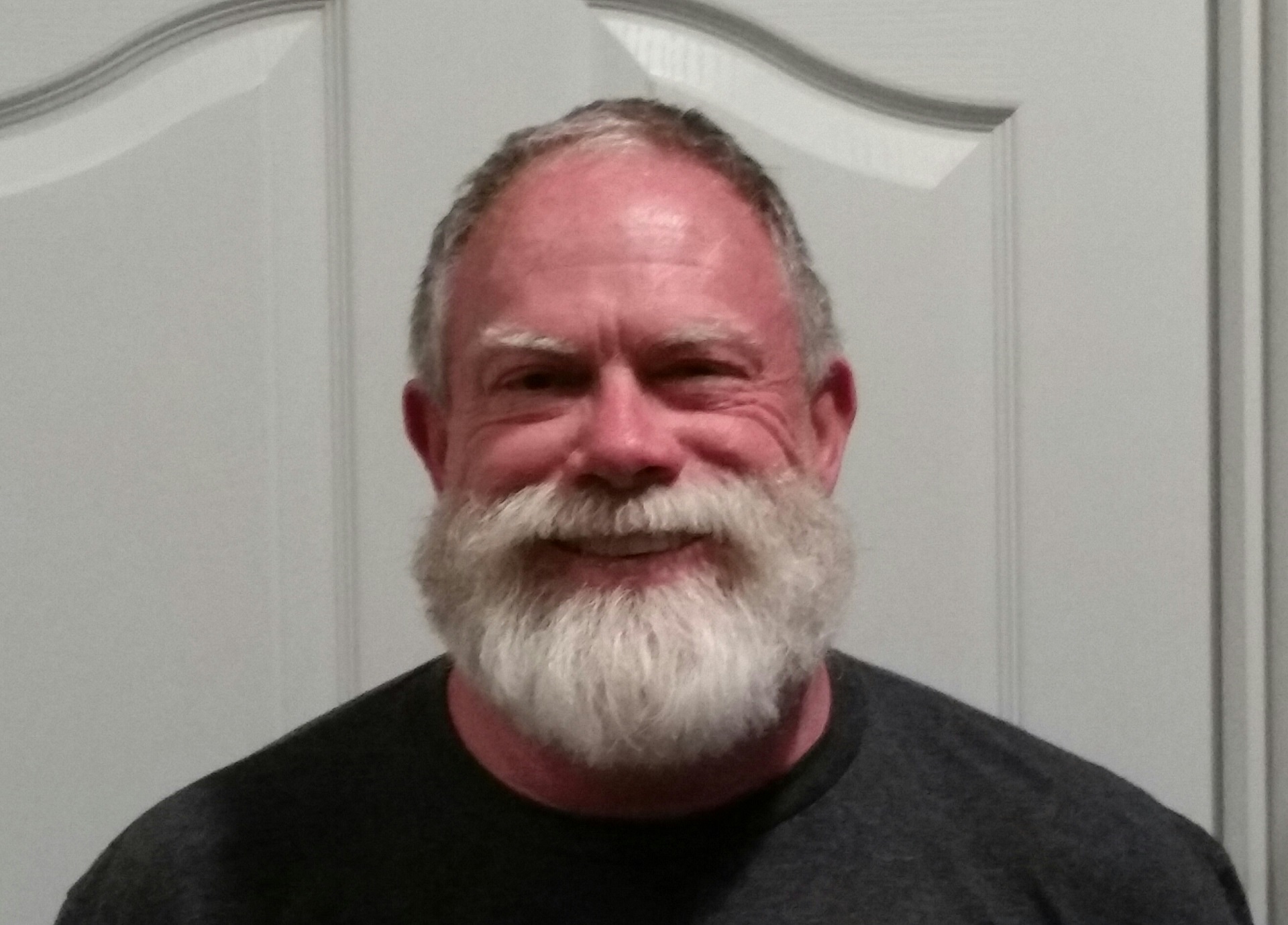
Artist Statement: My style reflects the era in which I live. I call my style Fractionalism as it is both the amalgamation of all ‘isms’ that have come before, but like our current ability to access fact, fiction, opinion and experience, it is fractured into segments of momentary, conditional observation. Hence our facts are countered by the slant of the presenter, the opinion of the writer or the goal of the organization which delivers it. This includes all news media as they are privately owned, all institutions of higher education as they are funded by trusts and political agendas, and any corporation or individual as their view is sequestered by the limitation of “knowing or experiencing all”. This places the artist in the position of realizing the broken, piece-meal experience he or she has in life as incomplete and possibly false or unfinished. My experience in this dawn of the age of communication is as flawed as anyone’s. What I hope to present is the beauty of this ongoing trial of living: the honing/polishing of view, the expanding inclusion, and the enlightening of those attempting to quell polarization. I have actually enjoyed the isolation that befell the world and used the alone time to delve more deeply into both the self and the growing world consciousness by assembling the fractured nature of the bits, the moments, that make up a life.
View Q&A with Morgan Johnson
Q: Amid a growing list of challenges our society faces today (the COVID-19 pandemic, ongoing racial injustice, climate change, gun violence, etc.), how has your artwork been influenced or affected?
A: At nearly 70 years of age, challenges to respond to current events have always been at the forefront of my expression. And [this approach] has always been two-pronged: adapt and incorporate current concerns all the while finding the beauty that lies within the subject. This has meant that my style, my voice, has had to evolve. As a young man, realism seemed the best way to express beauty and the awe I experienced as a maturing adult; now, with years of experience compounding my understanding, it seems that the disjointed, broken, partial and sometimes false narratives all need to exist within a painting to reflect my knowledge or position in an environment. This has led to multiple perspectives within a piece, forcing the eye/viewer to recognize there is no one truth, but actions of movement that follow possibilities.
Q: How has your process for submitting artwork to calls for entry on CaFÉ changed, if any? Is there anything that came out of the pandemic that has now become the norm for you?
A: Over the years using CaFÉ, my process has changed for how I enter my work for exhibition. Initially, 20 years ago, I attempted to submit my best visual work. In recent years, with calls incorporating very specific themes and societal concerns, I now try to match pieces to the demand. Calls used to be truly open (“show us your best work”); these days, institutions want to build more themed shows to address current hot button concerns they see as of interest to their public. My new norm is fewer submissions to these themed shows, and more to broader concept shows like landscape, figurative, line, color or abstract.
Q: What are your hopes or goals for the future as we emerge from the pandemic?
A: I’ve enjoyed the self-indulgence that the pandemic provided by requiring one to remain home and limit excursions. This also has meant I’ve had to get novel experiences or ideas from viewing or reading online. As safe mobility increases, and concerns about immediate risk subside, my goal is to try and maintain more studio time, and not be tempted by the everyday interactions that might take over time. This selfishness is also prompted by my natural aging: I see my best contribution to society as painting, so I want to do more of it and get it out more. While I find the advent of online shows intriguing, the concept of showing in a brick-and-mortar environment before truly investigative viewers still remains my preference.
Arthur Kobin
Website: www.arthurkobin.com
Instagram: @arthurkobin
I am a visual artist based out of San Diego, California. I produce primarily as a photographer, though I often cross mediums into music, drawing, painting, and writing. I aim to create works that illuminate existential absurdities between conceptual relationships, such as comedy and tragedy, violence and peace, beauty and crudeness.
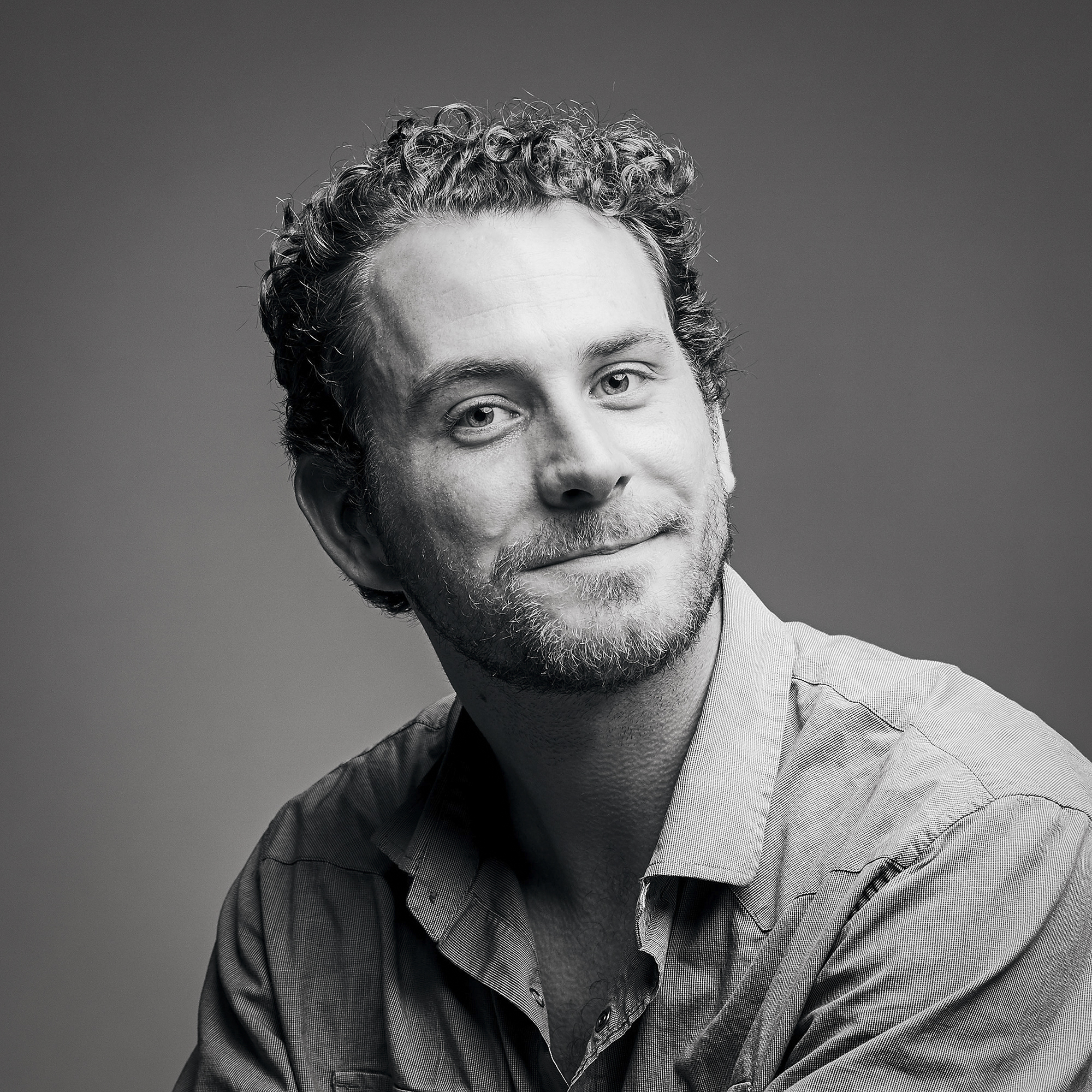
Artist Statement: In September 2021, I had the very fortunate opportunity to tag along with a friend on a business trip to Bogotá, Colombia. As an American who has only traveled internationally a few times, I found the experience illuminating, insightful, and distressing. To go from Southern California—where masks are rarely worn and vaccines are readily available—to the capital of Colombia—where masks are always worn and vaccines are not easily acquired – was a staunch reminder of global disparities. It was very difficult to explain to a local Bogotá resident that people in our country refuse to get vaccinated, while she and many people she knows were struggling to acquire vaccinations. The people that I spoke to in Colombia were welcoming, patient, and proud. They were aware of the problems that their country faced, but they still loved it – understandably so, as the natural surroundings and national parks were awe-inspiring. That being said, there was an undertone of socio-political tension in most areas, especially within the city. Corruption exists everywhere at varying levels, but it seems quite blatant in Colombia. My photos are that of an outsider—a hopefully conscientious tourist. This series is five of what could be myriad portraits of a vast, complicated culture and country. I intend to return and build a deeper relationship with Colombia and develop an expanded understanding of its people.
View Q&A with Arthur Kobin
Q: Amid a growing list of challenges our society faces today (the COVID-19 pandemic, ongoing racial injustice, climate change, gun violence, etc.), how has your artwork been influenced or affected?
A: I primarily create documentary photos of public subject matter, often relying on interaction with people. As a result of the pandemic-induced restrictions on public interaction, I found my focus shifted toward still-life moments and scenes from a distance.
Q: How has your process for submitting artwork to calls for entry on CaFÉ changed, if any? Is there anything that came out of the pandemic that has now become the norm for you?
A: As a result of the pandemic, I was able to focus more time on creating artwork and reconsider the intentions of my art. I was able to renew my appreciation for the luxury of interacting with strangers.
Q: What are your hopes or goals for the future as we emerge from the pandemic?
A: As we seemingly move past the pandemic, I hope to use my increased creative focus to build a body of work that will impact my existential perception and that of the public.
Daniel Merkowitz-Bustos
Website: danielmerkowitzbustos.myportfolio.com
Instagram: @daniel_merko
Daniel Merkowitz-Bustos is an artist based in Howard County, Maryland. His work often delves into the surreal and imaginary yet is grounded by a looming sense of reality. Playful yet dangerous, lighthearted yet serious, Daniel’s work surrounds itself in a juxtaposition of senses. Taking advantage of different artistic mediums, he creates his work using metal casting, welding, woodworking, textiles, photography, videography, and animation. Daniel draws his inspiration from his past and present, with interests from his childhood meeting things that currently interest him, most prominently of which is fashion.
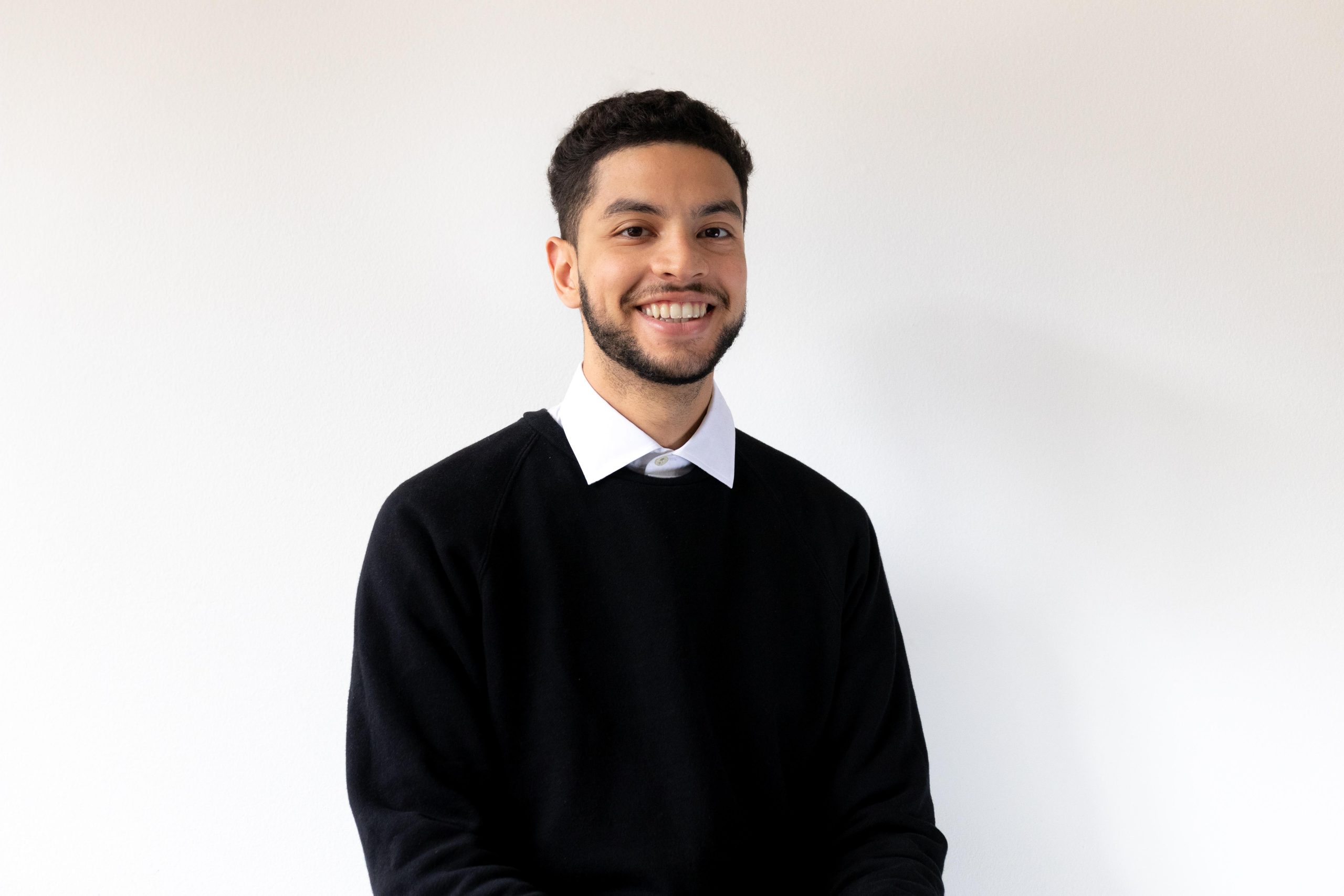
Artist Statement: The ever-present theme of playfulness remains in my work as I think about masculinity in fashion. My sculptures approach the duality of traditionally feminine and masculine elements by challenging the expectations of juvenile interests. The scary dinosaur meets the dainty princess, discovering the wonderful results that come from not constraining your self-expression to outdated paradigms. Spikes, molten foam, and pared-back palettes contrast bright and airy tulle throughout the collection. From the dress of a ballet dancer to wedding gowns, tulle is a strongly feminine fabric used almost exclusively in garments designed for women. Fusing this with objects that make the boy in me say “cool,” the pieces can no longer be boiled down to either masculine or feminine; there is a push and pull between those forces. The contrast serves as a point of interest, exemplifying the appeal of going against the status quo. There is no single template for what it means to be a man, nor is there on how to dress like one. In an era where the definition is so fluid, do what you like, and wear what you want. Confidently be yourself.
View Q&A with Daniel Merkowitz-Bustos
Q: Amid a growing list of challenges our society faces today (the COVID-19 pandemic, ongoing racial injustice, climate change, gun violence, etc.), how has your artwork been influenced or affected?
A: The challenges we currently face have impacted my work twofold. I have made work that specifically addresses the injustices we see. Last year I made a piece about the disparity in access and quality of healthcare people of color in the United States face. Alongside that, the content of my work, in general, has become more socially charged. I have recently been focusing on self-expression and the idea of masculinity in fashion. My art becomes my voice, and I have started to use that voice to speak up about issues that I care about and issues personal to me.
Q: How has your process for submitting artwork to calls for entry on CaFÉ changed, if any? Is there anything that came out of the pandemic that has now become the norm for you?
A: My process for submitting art has not really changed, though I have become more open to online exhibitions. It is certainly not the way I prefer to show my art, but it has become more normal.
Q: What are your hopes or goals for the future as we get out of the pandemic?
A: As we get out of the pandemic, I would like to take advantage of all the social aspects art has. Graduating during the pandemic put most of my shows online, taking away the opportunity to see people interact with my work and connect with other exhibiting artists. I hope to be able to start experiencing these things and be a part of the community the art world has to offer.
Artwork Featured: Ballerino, Tulle, wood, 2020, Roses, Tulle, spray paint, foam, gold, 2021, Pretty Dancer, Tulle, steel, aluminum, 2021, Cactus, Tulle, iron, glass, 2021, Peacock, Tulle, spray paint, foam, 2021. Photos courtesy of Daniel Merkowitz-Bustos.
Written by Communications Coordinator Justine Chapel

